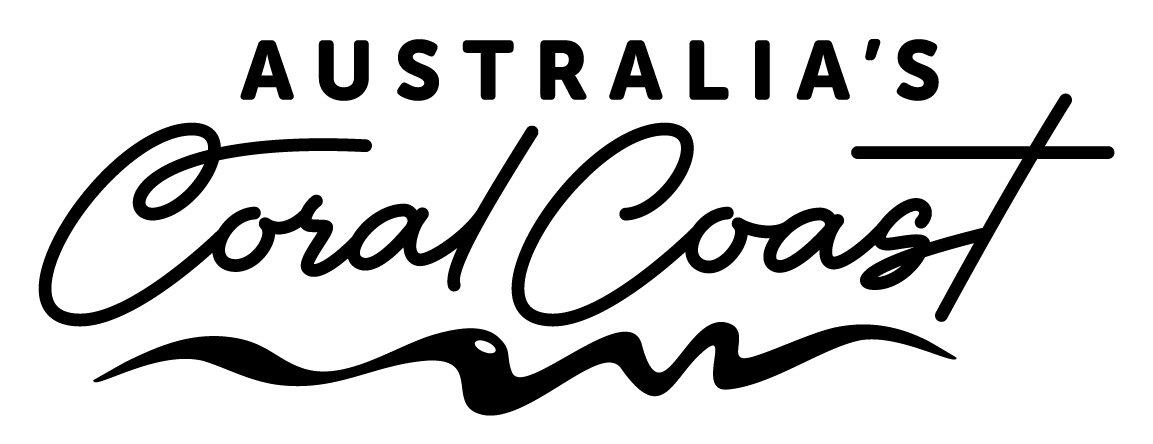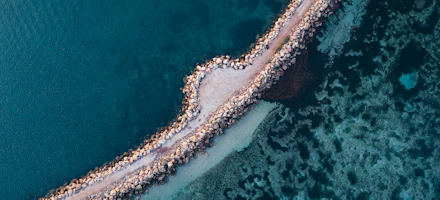
Carnarvon
Carnarvon is a subtropical oasis ideally situated between the Shark Bay and Ningaloo Coast World Heritage Areas.
The town and its surrounding areas are simultaneously a hub of adventure and a great place to rest, relax and recharge. Carnarvon is referred to as the 'food bowl' of Western Australia, producing 80% of the state's total fruit and vegetable crops and much of its seafood, with a thriving prawn, scallop, crab and fishing industry. Enjoy an abundance of fresh produce between immersing yourself in adventures and the culture and heritage of the Gascoyne region.
Carnarvon's central waterway, known as The Fascine, features several grassed picnic areas with BBQs, a swimming pontoon and children's playground, and is an ideal spot to catch the sunset whilst enjoying some local produce. Along the Fascine is the HMAS Sydney II Memorial, featuring 645 plaques to commemorate the lives lost aboard the HMAS Sydney II on 19 November 1941. The memorial was opened in early 2016 for the 75th anniversary of the ship's sinking.
Carnarvon is a 9.5 hour drive north of Perth, or a 2 hour flight with Regional Express Airlines. Alternatively, you can fly to Exmouth's Learmonth Airport with Qantas and drive 3.5 hours south to Carnarvon, or to Shark Bay's Monkey Mia Airport with Regional Express Airlines and drive 3 hours north to Carnarvon.
Culture, Heritage & History
There are several striking historic buildings in Carnarvon. Take a walking tour through the Heritage Precinct to learn about Carnarvon’s heritage buildings and rich history, or collect a guide from the Visitor Centre and set off along the Heritage, Art and Cultural Trail at your leisure. Make sure you take in the public art and 26-metre-long mural, which tells the town's history in a vivid way, along Carnarvon’s main street (Robinson Street).
Gwoonwardu Mia, Gascoyne Aboriginal Heritage and Cultural Centre is a multipurpose centre which celebrates the region's five Aboriginal language groups. Discover the region's Aboriginal history, art, heritage and culture through the Centre's permanent collection, exhibitions, Artist-in-Residence program and ethnobotanical garden. Peruse the gallery shop, showcasing work by Gascoyne regional artists, for a memento of your time in Carnarvon.
Visit Carnarvon's Space and Technology Centre to learn more about the town's little known role in space history! The Carnarvon Tracking Station played in the manned space program in the 1960s and 1970s, relaying the first steps of man on the moon to television stations in Australia, alongside Parkes Observatory. The Space and Technology Museum is located at OTC Satellite Earth Station, has various interactive displays and experiences including The Apollo (capsule) simulation, planetarium movies, NASA memorabilia, the space theatre and space shop. Open daily from 9:00am – 4:00pm (April to September) and 10:00am – 2:00pm (October to March).
Nature's Pantry
Food doesn't get much fresher than Carnarvon fresh. Fresh produce grows around Carnarvon all year, however the main plantation season runs from May to October. Follow the Gascoyne Food Trail along the scenic North and South River Roads, aptly known as "The Fruit Loop", past working plantations - some of which operate roadside stalls where you can pick up a wide range of preserves, dried fruits and ice-creams made fresh from seasonal fruit and vegetables. Don't forget to check out the #InstaWorthy Cactus Garden along the way.
Fruit, vegetables and seafood can also be purchased directly from farm gates and the weekly Gascoyne Growers Market, which takes place on Saturdays between May and October in front of the Visitor Centre. The markets offer local tropical fruits, homemade ice-creams, ready to eat meals (perfect for travellers!) and a wide variety of vegetables, herbs, honey, cakes, jams, relishes, plants and homemade crafts. Tip: the markets are plastic bag free, so make sure to bring along your reusable bags. The annual Gascoyne Food Festival takes place in August, so if you're travelling around this time make sure to add it to your list.
Carnarvon's fresh produce is thanks to the 865 kilometre-long Gascoyne River, the longest river in Western Australia. Water supply comes from aquifers (underground water systems) beneath and next to the river, creating an abundance of fertile soil along the river banks. Around 47,000 tonnes of fruit and vegetables are grown in the region each year, worth approximately $100 million, including a diverse range of tropical produce such as bananas, pawpaw, mangoes, grapes, tomatoes, avocados and beans.
Carnarvon's Seasonal Produce Calendar
| Year round | banana, butternut, cheery tomato, chilli, cucumber, eggplant, papaya |
| January | capsicum, honeydew, mango, rockmelon, sweet corn, table grapes, tomato, watermelon, passionfrui |
| February | capsicum, honeydew, mango, tomato, rockmelon, watermelon, passionfrui |
| March | custard apple, honeydew, mango, rockmelon, watermelon, passionfruit |
| April | beans, capsicum, custard apple, grapefruit, honeydew, kale, paprika, passionfruit, rockmelon, tomato, watermelon, zucchini |
| May, June, July & August | beans, capsicum, custard apple, grapefruit, honeydew, kale, okra, orange, paprika, passionfruit, rockmelon, sweet corn, tomato, watermelon (available until end June) |
| August & September | beans, capsicum, custard apple, grapefruit, honeydew, kale, nectarine, okra, orange, paprika, peach, plum, sweet corn, tomato, zucchini |
| October | beans, capsicum, custard apple, grapefruit, honeydew, kale, nectarine, okra, orange, paprika, peach, plum, rockmelon, sweet corn, tomato, watermelon, zucchini |
| November | beans, capsicum, custard apple, grapefruit, honeydew, mango, okra, orange, nectarine, paprika, peach, plum, rockmelon, sweet corn, tomato, watermelon, zucchini |
| December | honeydew, jackfruit, mango, rockmelon, table grapes, tomato, watermelon |
Fun fact: Carnarvon was the first location in Australia where bananas were grown! The first recorded appearance of bananas in Australia was in the early to mid-1800s, planted by Chinese migrants. From there, the banana industry in Carnarvon really started with a small planting in the 1940s. Since that time it has grown and become the hero of the town's horticulture industry. You can visit some of the banana plantations and select from Western Australia's best produce at the Gacoyne Grower's Markets, held in front of the Carnarvon Visitor Centre every Saturday morning between May and October. Carnarvon's bananas are smaller but sweeter than most of the big Queensland bananas found in Australian supermarkets. Some other key differences between Carnarvon and Queensland bananas are:
- Carnarvon bananas take 15 months to grow, compared to Queensland's 8 months. It may take longer, but we get a sweeter and creamier product!
- Queensland bananas are bigger in size, but Carnarvon's small size are perfect for a quick snack and easier for children to consume.
- Skin-marked rejects are sold as banana smoothie ingredients. The Carnarvon region has reduced the food waste ratio from 60% to just 4%! The average international wastage standard is 25-30%. Plantation operators are also value-adding and reducing waste by producing a massive range of quality sauces, jams, pickled fruit, wines, ice creams and dried fruit.
- Carnarvon is diverse! In addition to bananas, growers produce mangoes, watermelons, pumpkins and so much more.
- We are protected. Other banana growing locations around the world are challenged by TR4 (tropical race 4) disease, which affects Cavendish bananas. Our remote location and strict bio-hazard standards ensure this disease does not affect our plantations.
In addition to fresh foodie experiences and culture and history waiting to be discovered, there is also an abundance of natural attractions and adventures waiting for you in Carnarvon.
Adventure Awaits
Carnarvon is surrounded by dramatic spectacles and rugged landscapes. Witness the dramatic spectacle of the natural Blowholes and king waves. Take in the beautifully rugged surroundings and enjoy the surf at Gnaraloo, snorkel 'the aquarium' at Quobba, go wind or kite surfing at Red Bluff, and eco-camp at these locations.
For an off-the-beaten track 4WDing experience, head off to the Gascoyne Hinterland for the rugged outback to climb the world’s largest monocline, Mount Augustus, and explore the Kennedy Range National Park and its stunning Honeycomb Gorge. Or, see all of Carnarvon from above by Helicopter.
The Hinterland is also home to Rocky Pool, a great swimming spot (and day trip with picnic in tow!), located 55km east of Carnarvon on the Gascoyne Junction Road. Rocky Pool is a freshwater pool, and the picturesque setting makes for a wonderful day trip. No matter what time of year you visit the pool, you will be able to swim in the inviting waters thanks to the year round warm climate. Take a walk around the Rocky Pool admiring the beautiful ghost gum trees, float in the tranquil waters and explore the shallow pools for fossils that have been washed down from the Kennedy Ranges. Bring a picnic, or cook up a meal on the barbecues provided. Rocky Pool offers an opportunity to relax and appreciate the beautiful tranquil environment. Kangaroos do bounce by at dawn and dusk and the bird life is outstanding. Be sure to keep a watch for emus, goats and road trains on the road Gascoyne Junction.
Cape Cuvier Coast is a picturesque natural port close to the most westerly point of Australia. Driving along the spectacular rugged coastline you will be able to see the shipwreck of the bulk carrier Korean Star that ran aground following a cyclone in the area. From high up on the sixty metre cliff, in the winter months, you can see an incredible sight as whales and sharks pass by feeding on the schools of fish. Continue along the coastal road to see the remarkable blowholes that shoot water twenty metres up into the air. Be sure to visit Coral Bay where the reef comes into the shore and provides you with a rare opportunity to snorkel with whale sharks and manta rays. Cape Cuvier Coast is just ninety minutes from Carnarvon and a nine and a half hour drive north of Perth, and is accessible all year.












































